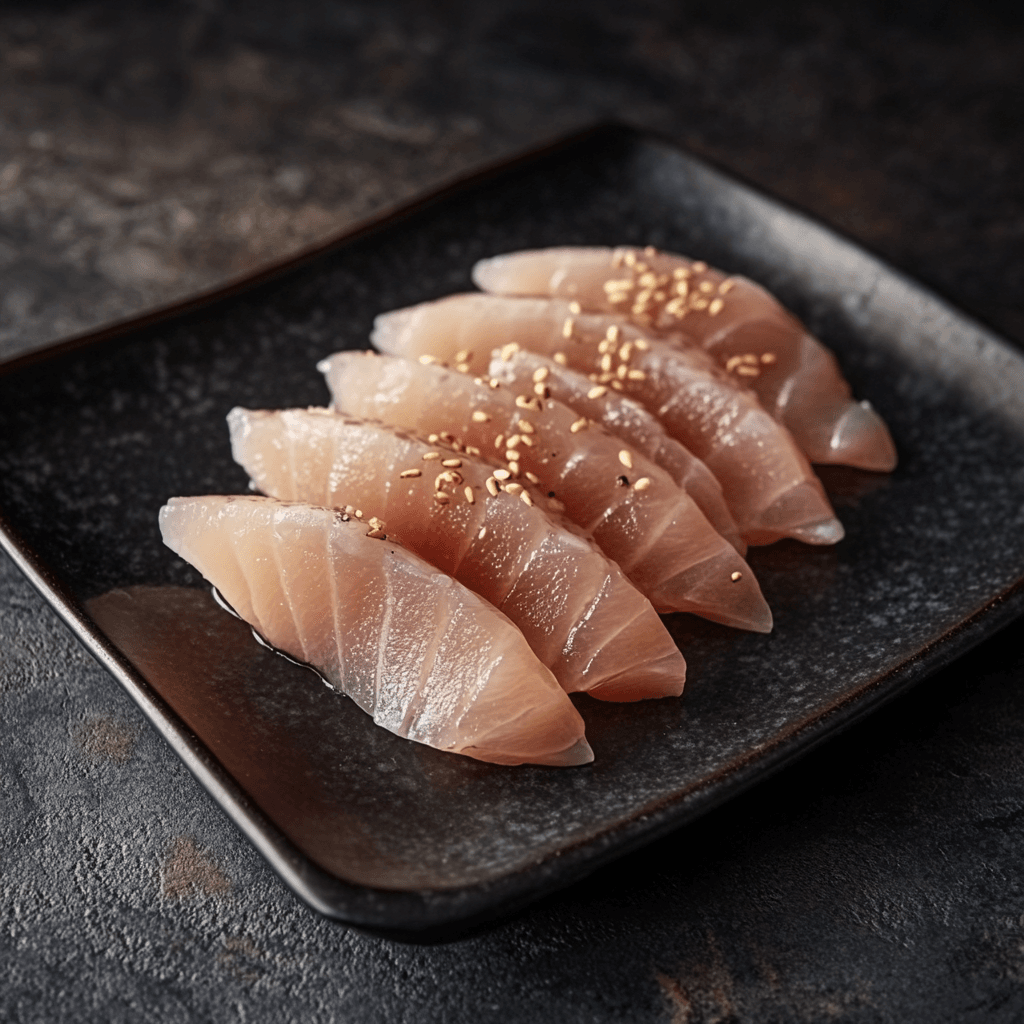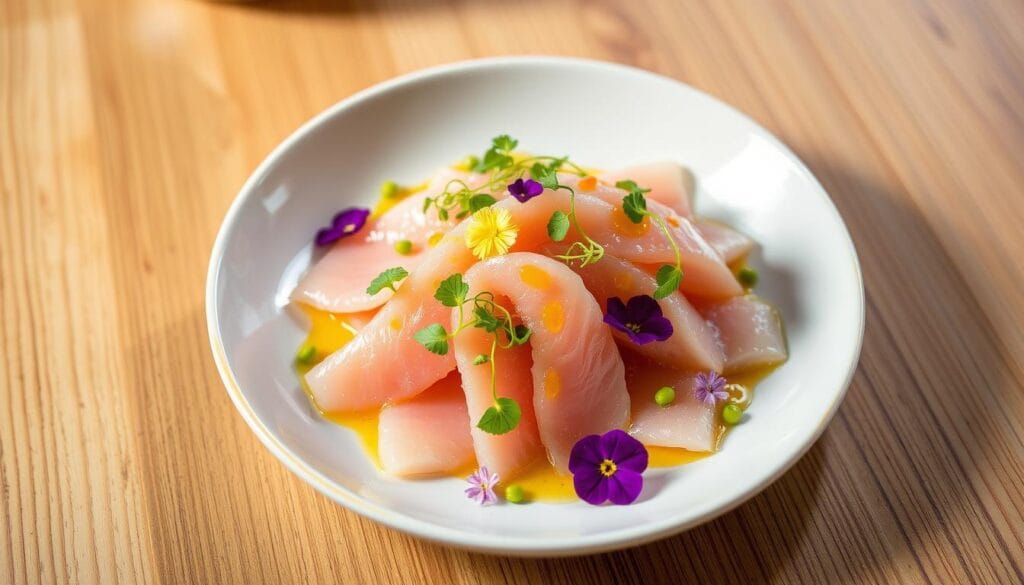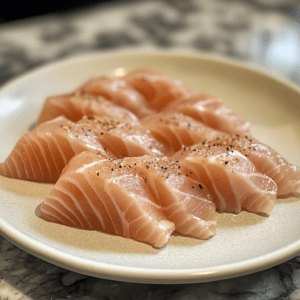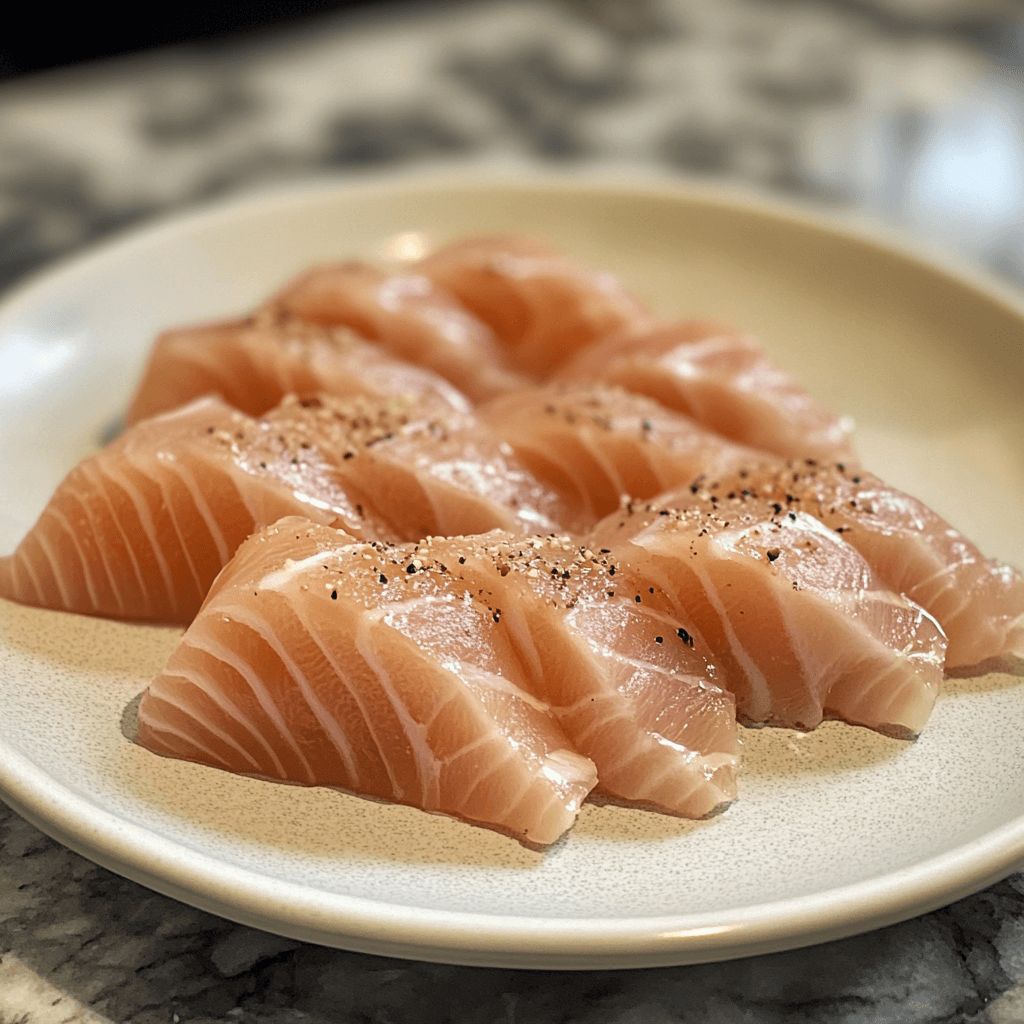As the sun set, a warm glow lit up the city. I was drawn to a cosy Italian restaurant in the neighbourhood. The smell of fresh seafood and herbs filled the air, making me hungry.
I was about to try something new that would change how I see raw fish. Hamachi crudo, a Japanese dish, was the main attraction. Thin slices of yellowtail, or “hamachi,” sparkled under the light. Its soft texture and sweet taste invited me to taste it.
When I took my first bite, the fish felt like it melted in my mouth. The flavours mixed beautifully, creating a delightful taste experience.
Key Takeaways
- Hamachi crudo is a Japanese-inspired dish featuring thinly sliced raw yellowtail fish.
- The dish originated in Japan but gained popularity in Italian cuisine, where it is known as “crudo”.
- Hamachi, or Japanese amberjack, is prized for its buttery texture and slightly sweet flavor.
- Proper slicing technique and the use of sushi-grade fish are essential for the perfect hamachi crudo.
- Hamachi crudo is often paired with complementary flavors like citrus, herbs, and spices to enhance the natural taste of the fish.
Understanding Hamachi: The Premium Japanese Yellowtail
Hamachi, or Japanese yellowtail, is a fish loved for its rich taste and soft, fatty texture. It’s found in the Pacific and Indian Oceans. People love it for its raw preparation quality.
What Makes Yellowtail Special for Raw Preparations
Yellowtail’s texture is firm but tender, and its taste is mild and clean. This makes it perfect for sashimi and crudo. The fish’s fat, especially around the belly, adds to its luxurious feel and flavor.
As it grows, it goes through stages like Wakashi (juvenile) and Hamachi (young adult). Finally, it becomes Buri (adult).
Difference Between Wild and Farmed Hamachi
Wild and farmed Hamachi are both prized, but they differ. Wild Hamachi has a more complex taste, showing its natural environment. Farmed Hamachi, however, is known for its consistent taste and texture. This makes it a favorite for restaurants and stores.
Nutrition Profile and Health Benefits
Hamachi is a low-calorie protein, making it a healthy choice. It’s full of omega-3 fatty acids and essential vitamins and minerals. But, like other big fish, it has some mercury. So, it’s best to eat it in moderation.
| Product | Price Range |
|---|---|
| Yellowtail Hamachi Premium Kama, Jumbo Pack, Frozen 1.5-2.4 lb | $17.88 – $24.29 |
| Yellowtail Hiramasa Collar, Frozen 16 oz | $8.99 – $12.79 |
| Uminoko Yellowtail Hamachi Premium Fillet, Sashimi Grade, Frozen | $35.99 – $39.99 |
“Hamachi is considered a relatively low-calorie protein option, making it a healthy choice.”
Essential Ingredients for Perfect Hamachi Crudo
Creating a delicious hamachi crudo starts with the best ingredients. Hamachi, or yellowtail, is a favorite in Japanese cooking. It’s known for its rich, buttery taste and delicate flavor when raw.
To make the perfect hamachi crudo, you need a few key things:
- Sashimi-grade yellowtail: It’s important to get high-quality, sushi-grade hamachi. This ensures the fish is safe to eat raw and tastes great.
- Citrus marinade: Mix yuzu or lemon juice, ponzu sauce, and a bit of sugar. This makes a tangy marinade that goes well with the fish.
- Flavorful garnishes: Add sliced jalapeño, scallions, cilantro, and tobiko for color, crunch, and extra flavor.
- Finishing touches: A drizzle of sesame oil and some flaky sea salt can make the dish even better.
The secret to a great hamachi crudo is mixing the fish’s fresh taste with the right marinade and garnishes. By using the best ingredients and following a few steps, you can make a dish that looks and tastes amazing. It will show off the beauty of this Japanese delicacy.
| Ingredient | Quantity |
|---|---|
| Hamachi (Yellowtail Kingfish) | 250g sashimi-grade fillet |
| Soy Sauce | 60ml |
| Orange | 1 |
| Lime | 1 |
| Sugar | To taste |
| Radishes | Thinly sliced |
| Green Onion | Thinly sliced |
| Red Chili Pepper | Thinly sliced |
| Red Onion | Thinly sliced |
With these ingredients, you’re ready to make a fantastic hamachi crudo. It will amaze your taste buds and impress your friends.

Step-by-Step Guide to Preparing Hamachi Crudo
For a mouthwatering hamachi crudo, the first step is to freeze the hamachi (Japanese yellowtail) for 30 minutes. This step is vital as it makes the slicing process easier and ensures the perfect sashimi texture. Once the hamachi is ready, use a sharp knife to cut it into thin slices against the grain, a technique that is key to achieving the ideal sashimi texture.
Next, it’s time to prepare the marinade. In a bowl, combine fresh lemon juice, soy sauce, chilli garlic sauce, honey, and olive oil. This marinade plays a crucial role in enhancing the flavour of the hamachi. Let the sliced hamachi soak in this delightful mix for 10 minutes, allowing it to absorb the flavours.
- Freeze the fresh hamachi for 30 minutes for easier slicing.
- Slice the hamachi thinly against the grain using a sharp knife.
- Make the marinade by mixing lemon juice, soy sauce, chilli garlic sauce, honey, and olive oil.
- Marinate the hamachi slices for 10 minutes.
The last step is plating and presentation. Arrange the marinated hamachi slices on a plate. Drizzle with marinade and garnish with fresh herbs, micro greens, and thinly sliced veggies. This makes the dish look stunning. Serve it right away to enjoy the fresh, vibrant flavours and perfect texture of the hamachi crudo.

“The secret to a perfect hamachi crudo is in the freshness of the fish and the balance of the marinade. With just a few simple steps, you can create a true culinary masterpiece.”
Traditional and Modern Sauce Combinations
Choosing the right sauce can really elevate your homemade hamachi crudo. Traditional Japanese flavours like ponzu sauce and yuzu kosho are great. They bring out the yellowtail’s sweetness.
For something new, try different sauces and marinades. A soy-ginger sauce with honey and rice vinegar is tasty. Adding balsamic reduction or truffle oil makes it fancy.
Using grapefruit, lime, or Meyer lemon can add a special touch. The goal is to balance flavours so they enhance the hamachi’s taste.
“The secret to a great hamachi crudo is in the sauce. It’s all about finding the right combination of flavors to complement the fish’s natural sweetness.”
Whether you go for traditional or modern flavours, you can create something unique. The key is to experiment and find the perfect sauce for your hamachi crudo.
The Art of Selecting Sushi-Grade Fish
Choosing the right sushi-grade fish is vital to making excellent hamachi crudo. This fish is called “sashimi-quality” and is safe to eat raw. It’s frozen to kill parasites, keeping it fresh and safe to eat.
Safety Guidelines for Raw Fish Consumption
To enjoy raw fish safely:
- Follow some important rules.
- Keep sushi-grade fish cold and eat it within a day.
- Learn how to thaw it right to keep its quality.
Where to Source Quality Hamachi
Finding top-notch hamachi can be tricky, but it’s worth it. Look for it at good fish markets, Japanese stores, and seafood shops. Choose fish that smells fresh and looks firm and clear. Stay away from fish that looks bad or smells too fishy.
| Fish Type | Popularity in Japan | Conservational Status |
|---|---|---|
| Pacific Bluefin Tuna | Very popular | Vulnerable |
| Atlantic Bluefin Tuna | Popular | Endangered |
| Salmon | Very popular | Least Concern |
| Yellowtail (Hamachi) | Very popular | Least Concern |
By following these tips and getting the best hamachi, you’ll make a tasty and safe sushi-grade fish dish. Your guests will love it.
Creative Garnishes and Accompaniments
Make your hamachi crudo dish stand out with creative garnishes and accompaniments. These add color, texture, and flavors that complement the crudo perfectly.
Begin with fresh, high-quality hamachi. Then, add these garnishes:
- Microgreens or edible flowers for a pop of color and a delicate, herbaceous note
- Citrus supremes, such as segments of grapefruit or orange, for a refreshing burst of acidity
- Toasted sesame seeds or crispy shallots for a delightful crunch
To enhance the Japanese appetizer, try these accompaniments:
- Sliced avocado for creamy richness
- Thinly sliced cucumber or radish for a refreshing contrast
- A small portion of seaweed salad or pickled ginger to cleanse the palate
These garnishes and accompaniments will make your hamachi pairing even better. They turn a simple dish into a feast for the eyes and taste buds, highlighting the Japanese yellowtail’s quality.
“The key to an exceptional hamachi crudo is the balance of flavors and textures. Carefully selected garnishes and accompaniments can transform a simple dish into a culinary masterpiece.”
| Beverage | Pairing Recommendation |
|---|---|
| Sauvignon Blanc | Bright acidity and citrus notes balance the richness of hamachi. |
| Albariño | Refreshing mineral-driven character pairs well with the delicate fish. |
| Unoaked Chardonnay | Allows the natural flavors of the hamachi to shine without oak interference. |
| Junmai Sake | Clean, balanced profile complements the subtle umami of the hamachi. |
| Ginjo Sake | Refined, aromatic character enhances the delicate flavors of the fish. |
Common Mistakes to Avoid When Making Hamachi Crudo
When making hamachi crudo, there are a few mistakes to watch out for. First, make sure you use sushi-grade fish that’s safe to eat raw, As low-quality hamachi can ruin the dish.
Another mistake is over-marinating the fish. A short marinade can add flavour, but too long can make the fish challenging. Try to keep the marinade time under 30 minutes.
Also, be meticulous about serving temperatures. The fish should be chilled but not too cold, preserving its delicate flavours. Equally important is maintaining a clean cooking environment to avoid contamination. Serve the crudo immediately after preparation for the best taste and your guests’ safety.
FAQ
What is hamachi crudo?
Hamachi crudo is a Japanese dish with thinly sliced raw yellowtail fish. It’s a favorite appetizer that highlights the hamachi’s clean, mild taste.
What is the origin of hamachi crudo?
Hamachi crudo comes from Japanese cuisine but is now loved in Italian restaurants. Hamachi is Japanese amberjack or yellowtail, known for its sweet taste and buttery texture.
What makes hamachi ideal for raw preparations?
Hamachi is prized for its rich flavor and fatty texture. It’s perfect for raw dishes because of its firm texture and mild taste. Wild hamachi has a more complex flavor, while farmed hamachi is consistent.
What are the key ingredients in hamachi crudo?
Hamachi crudo includes sashimi-grade yellowtail, yuzu or citrus juice, and ponzu sauce. It also has sesame oil and flaky sea salt. You might add jalapeño, scallions, cilantro, and tobiko for garnish.
How do you prepare hamachi crudo?
Start by freezing the fish briefly for easier slicing. Use a sharp knife to cut thin slices against the grain. Make a marinade with citrus juice, soy sauce, and oil.Arrange the fish slices on a plate, drizzle with the marinade, and garnish with herbs and thinly sliced vegetables.
What are some traditional and modern sauce combinations for hamachi crudo?
Traditional sauces include ponzu, a citrus-soy blend, and yuzu kosho, a spicy citrus paste. Modern options might have truffle oil, balsamic reduction, or miso-based sauces.
How do you select the best quality hamachi for crudo?
Choose sushi-grade fish that has been properly frozen to eliminate parasites. Look for fish with a fresh smell and firm, translucent flesh. The best places to find high-quality hamachi are reputable fish markets, Japanese grocery stores, or specialty seafood suppliers.
What are common mistakes to avoid when making hamachi crudo?
Avoid using fish that isn’t sushi-grade and don’t over-marinate the hamachi. This can “cook” the fish. Also, serve at the right temperature. Keep all utensils and surfaces clean to prevent contamination. Don’t over-garnish, as it can hide the hamachi’s natural flavor.

Hamachi Crudo
Equipment
- Sharp knife for slicing
- Freezer (for freezing the hamachi before slicing)
- Small mixing bowl
- Plate for serving
Ingredients
- 250 g sashimi-grade hamachi Yellowtail Kingfish fillet
- 60 ml soy sauce
- 1 orange juice
- 1 lime juice
- Sugar to taste
- Radishes thinly sliced
- Green onion thinly sliced
- Red chili pepper thinly sliced
- Red onion thinly sliced
Instructions
- Freeze the Hamachi: Place the hamachi fillet in the freezer for 30 minutes. This step helps to firm up the fish, making it easier to slice into thin, delicate pieces.
- Slice the Hamachi: Use a sharp knife to slice the hamachi fillet against the grain into thin slices, ensuring a perfect sashimi texture.
- Prepare the Marinade: In a small bowl, combine the soy sauce, fresh orange juice, lime juice, and sugar to taste. Stir well to dissolve the sugar.
- Marinate the Hamachi: Arrange the sliced hamachi on a plate. Drizzle the marinade over the fish and let it sit for about 10 minutes to absorb the flavors.
- Garnish and Serve: Top the marinated hamachi with thinly sliced radishes, green onion, red chili pepper, and red onion. Serve immediately to enjoy the fresh, vibrant flavors.
Notes
Marinating Time: Avoid over-marinating. A brief 10-15 minute soak is enough for the fish to absorb the marinade while maintaining its delicate texture.
Garnishes: Add variety with microgreens, edible flowers, citrus segments, sesame seeds, or even a touch of wasabi for extra flavor.
Serving Tip: Serve chilled, but not too cold, to ensure the fish’s flavor is not overwhelmed. Pair it with a refreshing drink like Sauvignon Blanc or Junmai Sake to complement the dish.

